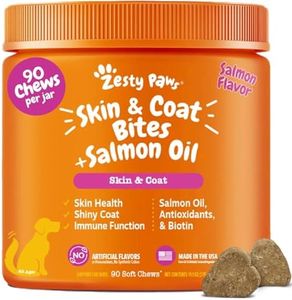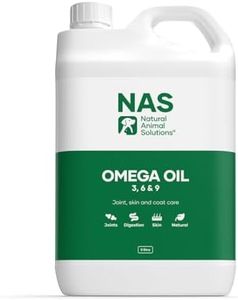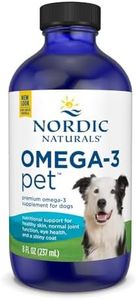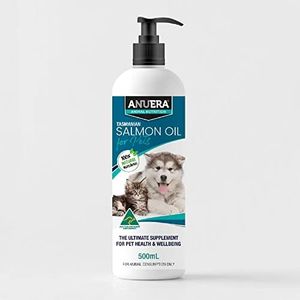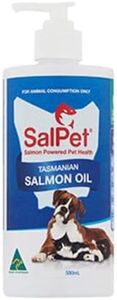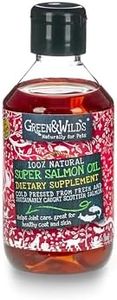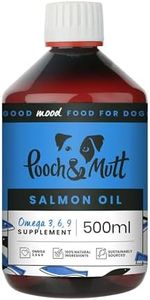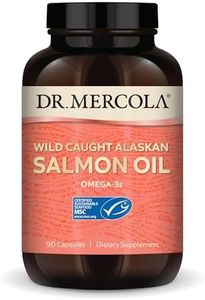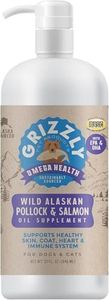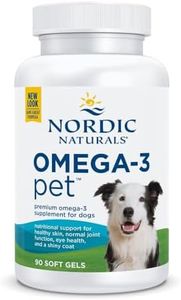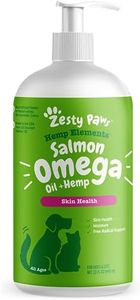We Use CookiesWe use cookies to enhance the security, performance,
functionality and for analytical and promotional activities. By continuing to browse this site you
are agreeing to our privacy policy
10 Best Salmon Oils For Dogs
From leading brands and best sellers available on the web.Buying Guide for the Best Salmon Oils For Dogs
Choosing the right salmon oil for your dog can boost their coat health, skin moisture, and overall well-being, thanks to the healthy fats and nutrients it contains. When selecting a salmon oil, it's important to look beyond marketing claims and understand how the main features affect your dog's health and your ease of use. Knowing key aspects can help you match a salmon oil to your pet's specific needs, whether it's for a shiny coat, joint support, or food appeal.Purity and SourcePurity refers to how clean and uncontaminated the salmon oil is, and the source tells you where and how the fish were caught. Pure oils from wild-caught salmon tend to have fewer pollutants and offer more natural nutrients. Salmon oil can be made from wild-caught or farm-raised fish; wild sources are often seen as cleaner, while farm-raised can be more affordable but sometimes include more additives. If your dog has sensitivities or you're worried about toxins (like mercury or PCBs), going for pure, wild-caught options is wise. If your dog's main need is basic support and they're healthy overall, farmed oil may be sufficient.
Omega-3 Content (EPA & DHA)Omega-3s, especially EPA (eicosapentaenoic acid) and DHA (docosahexaenoic acid), are the main beneficial fats in salmon oil, helping with inflammation, skin allergies, and joint or brain health. Bottles typically list total omega-3 percentage and sometimes break down EPA and DHA. High levels (above 25%) are generally best for dogs with skin/joint issues, while moderate amounts (15-25%) are good for maintenance. Lower levels (under 15%) may offer basic support but less therapeutic benefit. Choose higher omega-3 concentrations if your vet has recommended it or for older, active, or allergy-prone dogs; for young, healthy pets, moderate levels usually suffice.
Additives and PreservativesPreservatives keep the oil fresh, and additives can include flavorings or vitamins. Some oils are 100% pure, while others have added antioxidants (like Vitamin E) to prevent spoiling, or flavor boosters for picky eaters. If your dog is sensitive or allergic, opt for products with the fewest additives. For pets with no sensitivities and a picky appetite, natural flavor or antioxidant additions aren't usually a concern.
Form (Liquid, Capsule, or Pump)Salmon oil comes mostly as liquid (bottles or pumps), but you can also find capsules. Liquids are easy to add over food and dose by weight, but they can have a strong smell. Capsules are less messy and ideal for travel, but some dogs dislike taking pills. A pump bottle is convenient for daily dosing and limits spills. Pick the form that best matches your feeding routine—liquid for mixing easily with meals, capsules if you need mess-free or on-the-go use, and pump if quick, measured dosing is important.
Sustainability and CertificationsCertifications like 'sustainably sourced' signal that the fish were caught in ways that protect the environment. Third-party testing (sometimes noted by a seal) ensures safety and absence of heavy metals or toxins. If sustainability or eco-friendly practices matter to you, look for oils with official certifications for responsible sourcing. For most pet owners focused on their dog's health alone, safety certifications and purity are more critical to check.

